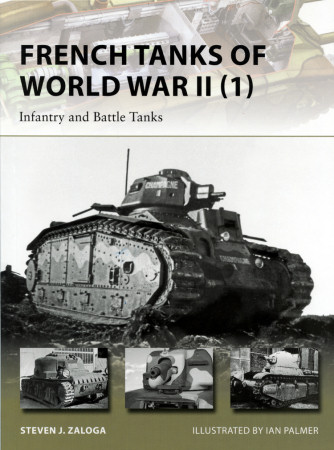
French Tanks of World War II (1) Book Review
By David L. Veres
| Date of Review | April 2014 | Title | French Tanks of World War II (1) |
|---|---|---|---|
| Author | Steven J. Zaloga | Publisher | Osprey Publishing |
| Published | 2014 | ISBN | 9781782003892 |
| Format | 48 pages, softbound | MSRP (USD) | $17.95 |
Review
In 1940, France mustered more and better tank designs then Nazi Germany did.
But despite generally superior vehicle numbers and quality, French armored elements faced serious logistical and doctrinal drawbacks. Germany, by contrast, leveraged major tactical and organizational advantages into stunning strategic success, conquering France in just six weeks.
Now in French Tanks of World War II – the first of two volumes from Osprey Publishing – Steven J. Zaloga expertly explains the complex interplay of military, political and economic factors facing France. And he deftly distills these through capsule case studies of 11 "infantry and battle" vehicles:
- Renault FT
- Char de Rupture 2C
- Char Léger D1
- Char Puissant D2
- Renault R35
- Char Léger FCM 36
- Hotchkiss H35 and H39
- Char B
- Char B1 bis
- Renault UE
- Chenillette Lorraine
The French, Zaloga astutely observes, suffered from a "profoundly defensive strategic outlook", "belated and grudging" interest in armored divisions, and operational defects.
For instance, despite the inclusion of modern, powerful designs into force structures, new armored divisions had "not yet worked out refueling procedures". And with the limited range of French tanks, this acutely compromised combat capabilities. The "belated formation" of French armored divisions also resulted in inadequate crew training and experience, further diluting unit performance.
Zaloga's splendid study also sports useful notes on "the arms race of the late 1930s", proposed, unrealized French tank designs, and bibliographic sources. Photos, extended captions and charts season text. And Ian Palmer's informative illustrations superbly spice the whole thing. Just savor that garish R35 on page 17!
The French Army apportioned armor into infantry and cavalry formations. And Osprey's second study surveys the latter. Look for it in July 2014.
I loved Zaloga's brilliant little book. Admirably indexed, it deserves pride of place in every World War II enthusiast's library. Now line-up behind me for Volume 2!
Robustly recommended.
My sincere thanks to Osprey Publishing for this review sample!







